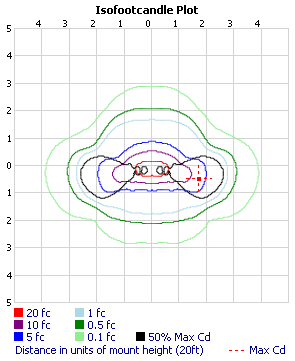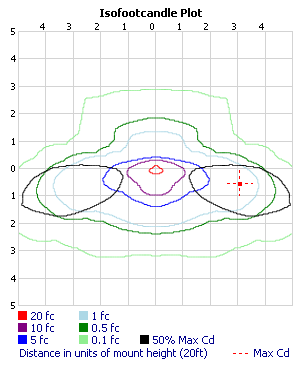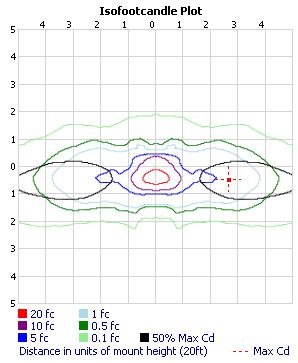LED's Optics
Comparing 3 Streetlights.
This section is where the LED will really shine, in a bad way. In other words, we will compare several similar fixtures with actual photmetric data
to see where they go wrong. Some of the things we'll be looking at are the footcandle plot, glare, and unwanted light distribution.
To do this, I will be using the Visual-3D software. NOTE: I am not sponsored by Visual-3D.
 Let's meet our first contender; the AEL 125, a fairly common model of cobrahead. For this comparison, the LED fixtures will be a
GE ERL2 streetlight and the AEL ATB1. To start, let's take a look at a simple photo that shows the performance of the AEL 125 when using a 400-watt HPS lamp.
The first thing you may notice is the rainbow of colorful lines. It looks complicated, but it really isn't. Start by looking at the little chart below the plot. It tells you the footcandles
(FC) that each line represents. Now, look at the very middle area and inspect the red line. That's the brightest one, and it is important for it to be more long than tall.
If it's tall, then light will be spilling off the road and nobody wants that. Luckily, this particular streetlight appears to not suffer from that.
Let's meet our first contender; the AEL 125, a fairly common model of cobrahead. For this comparison, the LED fixtures will be a
GE ERL2 streetlight and the AEL ATB1. To start, let's take a look at a simple photo that shows the performance of the AEL 125 when using a 400-watt HPS lamp.
The first thing you may notice is the rainbow of colorful lines. It looks complicated, but it really isn't. Start by looking at the little chart below the plot. It tells you the footcandles
(FC) that each line represents. Now, look at the very middle area and inspect the red line. That's the brightest one, and it is important for it to be more long than tall.
If it's tall, then light will be spilling off the road and nobody wants that. Luckily, this particular streetlight appears to not suffer from that.
Now look for the black and dashed line. The black one where the glare will be seen, and the dashed one shows where glare is highest. The goal is to keep the black line
from going a long ways, and this fixtue certaintly does that well. It also keeps the maximum glare level close to the center, and that's good as it won't be seen as far away as the LEDs we are going to look at. To continute, let's take a look at how much glare there actually is. From looking at the photometric data file (where all this info can be found) the maximum
glare is approximately 24,500 candela. Finally, let's finish this off by looking at the amount of light at high angles. From looking
at the glare level from 80-90 degrees, it has only 648 candela. Also, there are 1440 lumens shone from 70-100 degrees.
 Now let's see our next contender, the AEL LED, which I have selected to be a comparable model, as it has similar light-on-the-ground levels.
Take a look at its footcandle plot. It looks pretty similar, and in the middle it doesn't have a big red area, so we can give the LED a pass on that one. However,
this all changes with the glare. Take a look at the black line. It's so long it almost fills up the entire chart! In other words, this means that the glare level can be
seen from farther away. Adding to this, the dashed line is farther away from the center, which means a driver will experience the glare more.
Moving on to the next section, the photometrics say this LED streetlight has around 28,000 candela of glare. This is more than the HPS one, and could be enough
to distract drivers. It's time to see at the high-angle glare and light levels. This particular fixture creates a whopping 10,768 Cd (candela) from 80-90 degrees, and 6,626 lumens
from 70-100 degrees. That's a lotta light!
Now let's see our next contender, the AEL LED, which I have selected to be a comparable model, as it has similar light-on-the-ground levels.
Take a look at its footcandle plot. It looks pretty similar, and in the middle it doesn't have a big red area, so we can give the LED a pass on that one. However,
this all changes with the glare. Take a look at the black line. It's so long it almost fills up the entire chart! In other words, this means that the glare level can be
seen from farther away. Adding to this, the dashed line is farther away from the center, which means a driver will experience the glare more.
Moving on to the next section, the photometrics say this LED streetlight has around 28,000 candela of glare. This is more than the HPS one, and could be enough
to distract drivers. It's time to see at the high-angle glare and light levels. This particular fixture creates a whopping 10,768 Cd (candela) from 80-90 degrees, and 6,626 lumens
from 70-100 degrees. That's a lotta light!
 For the final contestant, the GE LED, take a look at the third photo to the right. There's not a lot to see here, other than the black line being slightly off the
charts and the max. glare level being farther away. The real action is in the candela levels, which are more extreme for this fixture than the two others. The candela level
for maximum glare is 32,000 and that's not all. Because this fixture makes 30,000 lumens, and the HPS one (which is what we're comparing these LEDs against) makes 36,000, the 32 thousand
Cd is lower than what it could be. As for the high-angle glare/light levels, this GE LED has 14,348 maximum candela from 80-90 degrees and 4,980 lumens from 70-
100 degrees.
For the final contestant, the GE LED, take a look at the third photo to the right. There's not a lot to see here, other than the black line being slightly off the
charts and the max. glare level being farther away. The real action is in the candela levels, which are more extreme for this fixture than the two others. The candela level
for maximum glare is 32,000 and that's not all. Because this fixture makes 30,000 lumens, and the HPS one (which is what we're comparing these LEDs against) makes 36,000, the 32 thousand
Cd is lower than what it could be. As for the high-angle glare/light levels, this GE LED has 14,348 maximum candela from 80-90 degrees and 4,980 lumens from 70-
100 degrees.
The conclusion:
We can see from checking the data for these 3 fixtures, that LED can create more glare and shines more light at high angles.
Also, if you want to check it for yourself, just follow these links:
AEL 125
AEL ATB2
For the GE ERL2, you will have to download the file and check it manually. The file:
GE ERL2
Homepage
Why LED is bad
Help Us Out
More Info
Yard Lights
LED Economics
Articles
About